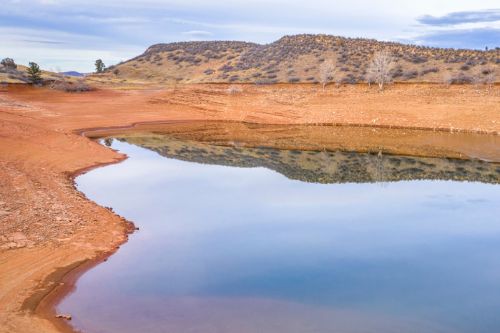Water Shortage Action Plan#
Water Restriction Level: Normal Conditions – No Restrictions
Updates on the status of our water supply will be posted at fcgov.com/water-status.
Overview#
The Water Shortage Action Plan (WSAP), previously known as the Water Supply Shortage Response Plan, establishes conditions and restrictions to manage Utilities' water supply in the event of projected water shortages as established by City Code Section 26-167(a).
Following a two-year review and engagement process, the plan was approved by City Council April 21, 2020, and is effective as of May 1, 2020.
WSAP Summary#
Water Restrictions#
The WSAP includes a comprehensive list of tactics and restrictions to be implemented in the event of a water shortage, as declared by the City Manager.
An effective response to water shortage requires a suite of strategies and tactics – no single water restriction will provide the response needed for most water shortages. The following guiding principles, not listed in order of priority or importance, will be followed as possible during a shortage.
- Restrict less-essential uses first and avoid restrictions on more essential uses.
- Minimize adverse economic impacts.
- Protect public and community activities.
- Implement extensive public information and media relations program.
- Avoid irretrievable loss of natural vegetation.
- Explore alternative water supply options.
Collaborate regionally and with other water service providers.
For a full list of water shortage tactics and strategies, including restrictions, see Chapter 1 of the WSAP.
Voluntary indoor water use strategies encourage optional and additional water use reductions based on water-efficient best practices and will be promoted concurrently during any mandatory outdoor water use restrictions.
Mandatory outdoor water use restrictions are required water use reduction strategies that are subject to monitoring and enforcement.
Alternative demand reduction actions may include a unique combination of mandatory restrictions and/or voluntary water restrictions. This level should be enacted when other levels are not adequate or appropriate to address a unique or extreme water shortage scenario.
| Action Summary Table | |||||
|---|---|---|---|---|---|
| Action Level | Water Shortage Watch - Voluntary | I - Low | II - Medium | III - High | IV - Alternative |
| % Projected Water Shortage | Potential Shortage | 1-15% | 16-25% | 26-35% | Unique and extreme water shortages not adequately or appropriately addressed by Water Shortage Watch or Levels I-III |
Permits#
Permits are available to allow for exceptions to assigned watering days and frequencies only, as described in Chapter 2 of the WSAP.
Permits may be issued for individuals or businesses unable to comply with watering restrictions for the following conditions:
- New seed and sod
- Medical/physical hardship
- Religious objection
- Large (four acres or greater) and City parks inactive areas
- City and Community active areas
- Raw or well water use
Enforcement#
Chapter 3 of the WSAP focuses on enforcement of water restrictions. The enforcement, including fines, and permitting functions for Utilities’ water restrictions are designed to ensure compliance with the WSAP, as well as City Code Section 26-166 (Prohibition of waste). Enforcement of restrictions, together with ongoing public education and outreach, are needed to achieve the goal of decreasing water demand, thus minimizing the need for greater water restriction action levels.
Future Updates#
Per Chapter 4 of the WSAP, regular and frequent review of the WSAP and water shortage action measures is critical to ensure Utilities’ staff and customers are prepared for a water shortage. The WSAP should be reviewed at least every five years, or sooner as new information becomes available. Updates may be necessary during or following a water shortage event, updates to either the Water Supply and Demand Management Policy or the Water Efficiency Plan, or changes to City Code. The next update should be considered in 2023-2024 for potential adoption in 2025.
FAQs#
-
A water shortage occurs when the projected water supply is less than the anticipated water demand with a set amount of water reserves in storage. Water supply is planned to include a storage reserve factor that equates to 20% of annual demand in storage through a 1-in-50 year- drought (a drought that has a 2% chance of occurring each year). The following events, or combination of, are examples that could trigger a water shortage:
- Drought (greater than a 1-in-50 year)
- Contamination or other water quality issues
- Treatment plant offline or another infrastructure issue
Fort Collins Utilities uses water supply projections, meteorological forecasts and available storage to estimate whether supplies are adequate to meet demand. If supplies are less than planned, water restrictions may be necessary in order to manage the availability of water for use in the immediate future or within the planning horizon for managing the water supply, as outlined in the current Water Shortage Action Plan. The plan applies only to customers in the Fort Collins Utilities service area.
-
![Neighborhood with dry lawns]()
- 2021– A Water Shortage Watch was enacted because of possible limitations on Fort Collins Utilities’ ability to treat Cache la Poudre River water supplies following the Cameron Peak Fire. Thunderstorms and flash floods caused sediment, ash and debris from the burn area to periodically flow into the river and impair water quality. These runoff events, in addition to irrigation demands during what was a hot and dry summer, had the potential to create a water shortage. This was the first time a voluntary watch has been declared following implementation of the WSAP.
- 2020 – The combined effects of the Horsetooth Outlet Project, drought and source water quality concerns from the wildfires created a risk of water shortage. Level IV outside water restrictions were enacted for 40 days in October-November to help lower water demand.
- 2013 – Due to drought and water quality concerns following the High Park and Hewlett fires, level 1 outside water restrictions were briefly enacted in April and May. The fires carried soil and ash into the Poudre River, causing water contamination and the Colorado-Big Thompson quota for Horsetooth Reservoir was initially lower than usual.
- 2002 – Due to drought, the City responded with level 1 restrictions in July and August, followed by more-stringent level 2 restrictions (one day per week watering) beginning in September.
-
Water Efficiency is Always Encouraged#
- Water efficiency is strongly encouraged year-round. Utilities offers several programs to help residents and businesses conserve water.
- Even without restrictions, lawn watering two days per week is typically enough. During hot, dry weather, a third day may be needed.
- Free sprinkler system audits can help you run your system most efficiently.
- The City's wasting water code will continue to be enforced. Notify Utilities of leaks, flowing or pooling water to help save water.
For More Information#
For questions or more information, contact savewater@fcgov.com, 970-221-6719 or V/TDD 711.
Did You Know?
There is no poop fairy. Pick up after your pet to help prevent stormwater pollution.
We operate a flood warning system that monitors real-time rainfall information.
Sprinkler systems can be designed, installed and operated with water-efficiency in mind.

